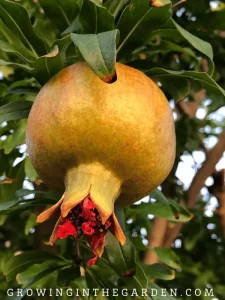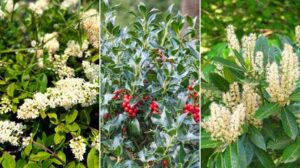Curb Appeal: The Best Shrubs for the Front of Your House
Your home’s curb appeal is the first impression that guests get, and it can make a big difference in how they perceive your property. A well-maintained yard with attractive landscaping can make your home look more inviting and valuable, while a neglected yard can send the opposite message.
If you’re looking to improve your home’s curb appeal, one of the best things you can do is add some shrubs to the front of your property. Shrubs can add color, texture, and interest to your landscape, and they can also help to define your property’s boundaries.

In this article, we’ll discuss the best shrubs for the front of your house, and we’ll provide tips on how to choose and care for them. So if you’re ready to give your home’s curb appeal a boost, read on!
The Best Shrubs for Curb Appeal
The Best Shrubs for Curb Appeal
When it comes to curb appeal, shrubs can make a big difference. They can add color, texture, and height to your landscape, and they can also help to define your property and create a welcoming first impression.
When choosing shrubs for your front yard, there are a few things to keep in mind.
You don’t want to choose shrubs that are too large for your yard, or they will end up looking out of place. Second, think about the amount of sun and shade your yard gets. Some shrubs prefer full sun, while others do better in partial shade. consider the overall look you’re trying to achieve. Do you want a formal, manicured look, or a more relaxed, natural look?First, consider the size of your space..
Once you’ve considered these factors, you can start choosing shrubs for your front yard. Here are a few of our favorites:
- Boxwood: Boxwood is a classic choice for curb appeal. It’s a dense, evergreen shrub that can be shaped and trimmed to create a variety of different looks. Boxwood does well in full sun or partial shade, and it’s relatively low-maintenance.
- Hydrangea: Hydrangeas are beautiful, flowering shrubs that add a touch of elegance to any landscape. They come in a variety of colors, and they can be grown in full sun or partial shade. Hydrangeas are relatively easy to care for, but they do require regular watering.
- Rose: Roses are a popular choice for curb appeal because they’re beautiful and fragrant. There are many different varieties of roses to choose from, so you can find one that’s perfect for your climate and growing conditions. Roses do require some care, but they’re well worth the effort.
- Viburnum: Viburnums are versatile shrubs that can be used in a variety of different landscapes. They come in a variety of sizes and shapes, and they offer beautiful flowers, berries, and foliage. Viburnums are relatively easy to care for, and they’re resistant to pests and diseases.
These are just a few of the many great shrubs that you can choose for your front yard. By considering the size, sun exposure, and overall look you’re trying to achieve, you can create a beautiful and inviting curb appeal that will make your home stand out from the rest.
How to Choose the Right Shrubs for Your Home
How to Choose the Right Shrubs for Your Home
Shrubs can add beauty, interest, and function to your home landscape. They can provide privacy, screening, and windbreaks. They can also help to attract birds and other wildlife.
When choosing shrubs for your home, there are a few things to keep in mind.
- Size: Consider the size of the shrub when it is mature. Make sure that it will not outgrow the space you have available.
- Sunlight: Most shrubs need full sun, but some can tolerate partial shade. Be sure to choose shrubs that will thrive in the amount of sunlight you have available.
- Water needs: Some shrubs are drought-tolerant, while others need regular watering. Make sure to choose shrubs that will be able to tolerate the amount of water you are able to provide.
- Hardiness zone: Shrubs are rated for their hardiness zone, which indicates the minimum temperature they can withstand. Be sure to choose shrubs that are hardy in your climate zone.
Once you have considered these factors, you can start choosing shrubs for your home. Here are a few tips:
- Choose a variety of shrubs in different shapes, sizes, and colors. This will create a more interesting and visually appealing landscape.
- Group shrubs together in clusters for a more dramatic effect.
- Use shrubs to create focal points in your landscape. This could be a single, large shrub or a group of smaller shrubs.
- Use shrubs to fill in empty spaces in your landscape. This could be along a walkway, around a patio, or at the edge of your property.
With a little planning, you can choose the right shrubs to create a beautiful and functional landscape for your home.
Table of Common Shrubs for Home Landscapes
| Shrub | Size | Sunlight | Water Needs | Hardiness Zone |
|---|---|---|---|---|
| Abelia | 3-6 feet tall and wide | Full sun to partial shade | Moderate | 4-9 |
| Boxwood | 2-6 feet tall and wide | Full sun to partial shade | Low | 5-9 |
| Crabapple | 10-20 feet tall and wide | Full sun | Moderate | 4-9 |
| Hydrangea | 3-6 feet tall and wide | Full sun to partial shade | Moderate | 4-9 |
| Lilac | 6-12 feet tall and wide | Full sun | Moderate | 4-9 |
| Rose | 3-6 feet tall and wide | Full sun | Moderate | 4-9 |
| Viburnum | 3-10 feet tall and wide | Full sun to partial shade | Moderate | 4-9 |
Shrubs are a great way to add beauty and interest to your landscape. They can provide structure, screening, and color, and they can also help to attract wildlife. But before you can enjoy the benefits of shrubs, you need to know how to plant and care for them.
Planting Shrubs
When planting shrubs, it is important to choose the right location. Shrubs need full sun to partial shade, depending on the species. They also need well-drained soil. If your soil is heavy clay, you may need to amend it with compost or sand to improve drainage.
Dig a hole that is twice the width of the shrub’s root ball. Place the shrub in the hole and fill it with soil, tamping it down firmly. Water the shrub thoroughly.
Caring for Shrubs
Once your shrubs are planted, it is important to care for them properly. This includes watering, fertilizing, and pruning.
Water your shrubs regularly, especially during dry spells. Fertilize them in spring and fall with a balanced fertilizer. Prune your shrubs as needed to maintain their shape and size.
Shrub Problems
Shrubs can occasionally be affected by pests and diseases. If you notice any problems, consult with a qualified arborist or horticulturalist for advice.
Shrubs for the Front of Your House
When choosing shrubs for the front of your house, it is important to consider the size, shape, and color of the shrubs. You also need to consider the amount of sun and shade that the area receives.
Here are some good options for shrubs for the front of your house:
- Azaleas are a popular choice for the front of the house. They come in a variety of colors and sizes, and they are relatively easy to care for.
- Crabapple trees are another good option for the front of the house. They are deciduous trees that produce beautiful flowers in spring.
- Holly shrubs are evergreen shrubs that provide year-round interest. They are also very tolerant of a variety of conditions.
- Rose bushes are a classic choice for the front of the house. They come in a variety of colors and sizes, and they are very fragrant.
These are just a few of the many options available for shrubs for the front of your house. By choosing the right shrubs, you can create a beautiful and inviting landscape that you will enjoy for years to come.
Common Shrub Problems and Solutions
Common Shrub Problems and Solutions
Shrubs can add beauty and interest to your landscape, but they can also be susceptible to a variety of problems. Here are some of the most common problems and solutions:
- Disease: Shrubs can be affected by a variety of diseases, including fungal diseases, bacterial diseases, and viral diseases. Fungal diseases are often caused by wet conditions, and they can cause leaves to turn yellow, brown, or black. Bacterial diseases can cause leaves to wilt, and they can also cause dieback. Viral diseases can cause leaves to become mottled or distorted.
- Insects: Shrubs can be attacked by a variety of insects, including aphids, caterpillars, scale insects, and mites. Aphids suck sap from leaves, causing them to wilt and turn yellow. Caterpillars eat leaves, causing them to become ragged and chewed. Scale insects and mites suck sap from leaves and stems, causing them to become discolored and stunted.
- Animals: Shrubs can also be damaged by animals, such as deer, rabbits, and groundhogs. Deer will eat the leaves of shrubs, rabbits will eat the bark, and groundhogs will burrow under shrubs.
The following table provides a summary of common shrub problems and solutions:
| Problem | Solution |
|---|---|
| Disease | Treat with fungicide or bactericide |
| Insects | Spray with insecticide or insecticidal soap |
| Animals | Protect with fencing or repellents |
By following these tips, you can help keep your shrubs healthy and beautiful.
Tips for Creating a Beautiful Shrub Border
Tips for Creating a Beautiful Shrub Border
Shrub borders are a great way to add beauty and interest to your landscape. They can also help to define your property lines and create a sense of privacy. Here are a few tips for creating a beautiful shrub border:
- Choose the right shrubs for your climate and location. Some shrubs are more drought-tolerant than others, so it’s important to choose plants that will thrive in your area. You also need to consider the amount of sun and shade your border will receive.
- Plan your layout carefully. Before you start planting, take some time to sketch out a plan for your border. This will help you to visualize how the different plants will look together and make sure that you have enough space for each one.
- Plant your shrubs at the correct depth. Shrubs should be planted so that the top of the root ball is level with the soil. If you plant them too deep, they won’t be able to get enough oxygen and will eventually die.
- Water your shrubs regularly. Newly planted shrubs need to be watered regularly, especially during dry periods. Once they’re established, you can reduce the watering frequency, but it’s still important to keep them well-hydrated.
- Fertilize your shrubs regularly. Fertilizing your shrubs will help them to grow strong and healthy. Use a fertilizer that is specifically formulated for shrubs and follow the package directions for application rates.
Shrub Borders by Season
Shrub borders can be beautiful all year round, but they each have their own unique charms. Here’s a look at some of the best shrubs to use for each season:
- Spring: Spring-flowering shrubs like azaleas, lilacs, and rhododendrons add a burst of color to the landscape.
- Summer: Summer-flowering shrubs like hydrangeas, roses, and spireas provide continuous blooms throughout the season.
- Fall: Fall-foliage shrubs like maples, oaks, and viburnums add color to the landscape as the leaves change color.
- Winter: Evergreen shrubs like holly, juniper, and boxwood provide structure and interest to the landscape during the winter months.
Bringing Curb Appeal to Your Home
Bringing Curb Appeal to Your Home
Curb appeal is the first impression that your home makes on visitors. It’s what they see when they drive by, and it can make a big difference in whether or not they decide to stop and take a closer look.
There are a few things you can do to improve the curb appeal of your home, and one of the best ways is to add some shrubs to the front yard. Shrubs can add color, texture, and interest to your landscape, and they can also help to define your property and create a more welcoming environment.
When choosing shrubs for your front yard, it’s important to consider the size, shape, and color of the plants. You want to choose shrubs that will complement the architecture of your home and the surrounding landscape. You also want to make sure that the plants are the right size for your yard.
Here are a few tips for choosing shrubs for your front yard:
- Choose shrubs that are hardy in your climate.
- Choose shrubs that are the right size for your yard.
- Choose shrubs that will complement the architecture of your home and the surrounding landscape.
- Choose shrubs that are low-maintenance.
Here are some of the best shrubs for the front of your home:
- Boxwood: Boxwood is a classic choice for front yards. It’s a dense, evergreen shrub that can be trimmed into a variety of shapes. Boxwood is also very low-maintenance.
- Hydrangea: Hydrangeas are beautiful, flowering shrubs that come in a variety of colors. They’re best suited for yards with full sun or partial shade.
- Roses: Roses are a popular choice for front yards because they’re so beautiful. Roses come in a variety of colors, shapes, and sizes. They’re best suited for yards with full sun.
- Viburnum: Viburnums are deciduous shrubs that produce beautiful flowers in the spring. They’re best suited for yards with full sun or partial shade.
- Azaleas: Azaleas are deciduous shrubs that produce beautiful flowers in the spring. They’re best suited for yards with full sun or partial shade.
By adding some shrubs to your front yard, you can improve the curb appeal of your home and create a more welcoming environment.
Resources
The Spruce: Best Shrubs for Front Yards
- Gardening Know How: Shrubs for Front Yards
The Way Forward
Outro
Shrubs are an easy and affordable way to add curb appeal to your home. With so many different varieties to choose from, you’re sure to find the perfect ones to fit your needs and style. So what are you waiting for? Start adding some shrubs to your front yard today!
- Visit your local nursery to find the perfect shrubs for your home.
- Read more articles about landscaping and gardening on our blog.
- Sign up for our newsletter to stay up-to-date on the latest trends in home improvement.
- Cat Palm vs Majesty Palm: Which Should You Choose? - June 30, 2024
- Flowers That Survive Winter: Discover the Exceptional No. 5 - June 30, 2024
- The Ultimate Guide to the Growth and Care of the Black Pagoda Lipstick Plant - June 29, 2024





